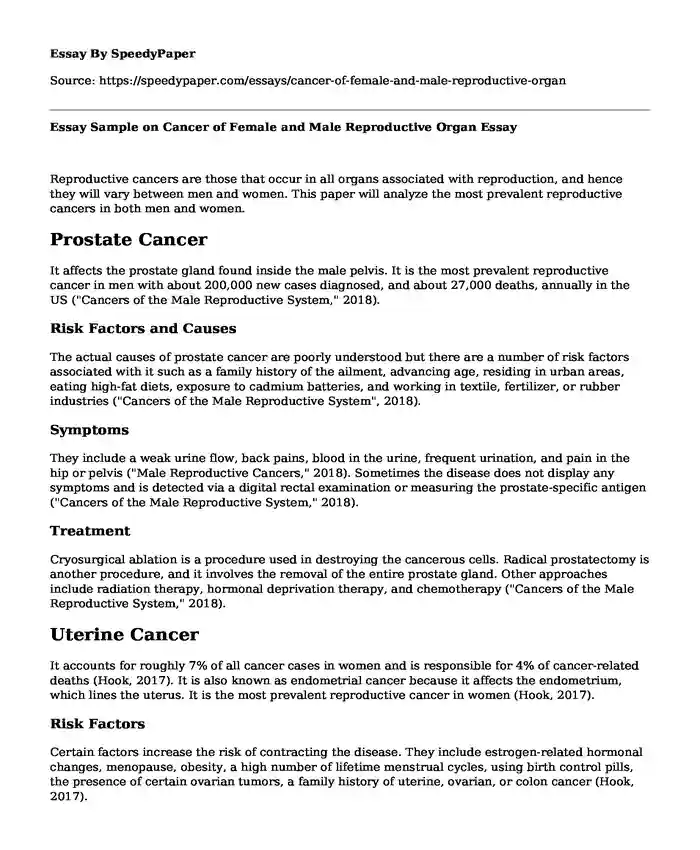Reproductive cancers are those that occur in all organs associated with reproduction, and hence they will vary between men and women. This paper will analyze the most prevalent reproductive cancers in both men and women.
Prostate Cancer
It affects the prostate gland found inside the male pelvis. It is the most prevalent reproductive cancer in men with about 200,000 new cases diagnosed, and about 27,000 deaths, annually in the US ("Cancers of the Male Reproductive System," 2018).
Risk Factors and Causes
The actual causes of prostate cancer are poorly understood but there are a number of risk factors associated with it such as a family history of the ailment, advancing age, residing in urban areas, eating high-fat diets, exposure to cadmium batteries, and working in textile, fertilizer, or rubber industries ("Cancers of the Male Reproductive System", 2018).
Symptoms
They include a weak urine flow, back pains, blood in the urine, frequent urination, and pain in the hip or pelvis ("Male Reproductive Cancers," 2018). Sometimes the disease does not display any symptoms and is detected via a digital rectal examination or measuring the prostate-specific antigen ("Cancers of the Male Reproductive System," 2018).
Treatment
Cryosurgical ablation is a procedure used in destroying the cancerous cells. Radical prostatectomy is another procedure, and it involves the removal of the entire prostate gland. Other approaches include radiation therapy, hormonal deprivation therapy, and chemotherapy ("Cancers of the Male Reproductive System," 2018).
Uterine Cancer
It accounts for roughly 7% of all cancer cases in women and is responsible for 4% of cancer-related deaths (Hook, 2017). It is also known as endometrial cancer because it affects the endometrium, which lines the uterus. It is the most prevalent reproductive cancer in women (Hook, 2017).
Risk Factors
Certain factors increase the risk of contracting the disease. They include estrogen-related hormonal changes, menopause, obesity, a high number of lifetime menstrual cycles, using birth control pills, the presence of certain ovarian tumors, a family history of uterine, ovarian, or colon cancer (Hook, 2017).
Symptoms
The most common signs of uterine cancer include trouble during urination, pain in the pelvis, pain during intercourse, and abnormal vaginal discharge or bleeding ("Uterine Cancer," 2018).
Treatment
The most common approach in treatment is a hysterectomy, which is a surgical procedure to remove the uterus. Sometimes the fallopian tubes and ovaries are also removed in treatment. Other approaches include chemotherapy, radiation therapy, and hormone therapy ("Uterine Cancer," 2018).
References
Cancers of the Male Reproductive System. (2018). Retrieved from http://www.familyfertilityplan.com/mens-sexual-health/male-reproductive-cancers.aspx
Hook, D. (2017). The Top 5 Cancers Affecting Women. Retrieved from https://www.everydayhealth.com/womens-health/cancers-affecting-women-today.aspx
Male Reproductive Cancers. (2018). Retrieved from https://www.hhs.gov/opa/reproductive-health/fact-sheets/cancers/male-reproductive-cancers/index.html
Uterine Cancer. (2018). Retrieved from https://medlineplus.gov/uterinecancer.html
Cite this page
Essay Sample on Cancer of Female and Male Reproductive Organ. (2022, Jun 22). Retrieved from https://speedypaper.net/essays/cancer-of-female-and-male-reproductive-organ
Request Removal
If you are the original author of this essay and no longer wish to have it published on the SpeedyPaper website, please click below to request its removal:
- Vice President of Operations - Free Essay with Job Description
- Essay Example on Nursing: Extra Fentanyl Patch Error
- Free Essay Sample on New Diseases
- Free Essay on the Book by Brian Greene: The Elegant Universe
- Essay Example Dedicated to Solar Panel Cleaning Robots
- Free Paper Sample: Security Infrastructure Design for a Retail Company
- Essay Example about China and Economic Globalization
Popular categories





